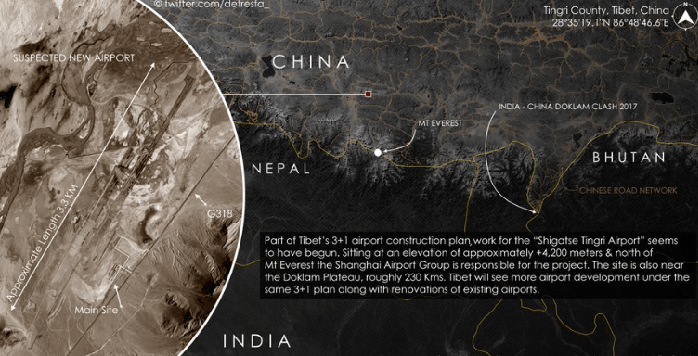China has begun the construction of Shigatse Tingri airport in Tibet as part of the 3+1 airport construction project to boost air connectivity in the region, reveal the satellite images, accessed by the open-source intelligence, Twitter handle Detresfa.
Japanese F35s, US Navy Display Their ‘Muscle Power’ Amid Chinese Belligerence In The Indo-Pacific
Part of #China's #Tibet 3+1 Airport Construction plan aimed at boosting air connectivity in the region, work on a new airport seems to have begun in Tingri County, the site is roughly 230 Kms from #Doklam as well, where #India & #China clashed in 2017 pic.twitter.com/JlOWEivpGJ
— d-atis☠️ (@detresfa_) October 23, 2020
Located between Tingri and Lhatse counties of Shigatse City, north of Zangmu, the border post with Nepal, the airport is about 230 km from Doklam, where Indian and Chinese troops had clashed in 2017. The images show 3.3 km length of the area marked as a new site for the airport.
The 2017 military stand-off between Chinese and Indian soldiers in Doklam plateau had erupted over the construction of a highway in the contested territory.
The other two airports part of the 3+1 project are Lhuntse and Purang, which are at a short distance from the Indian border.
Japanese F35s, US Navy Display Their ‘Muscle Power’ Amid Chinese Belligerence In The Indo-Pacific
The airports, part of the connectivity project, are a cause of concern for India because these will be under the “dual-use” as per law, which means they are being built to suit both the civilian and military standards.
China has 60 such airports. The People’s Liberation Army can use them whenever required.
The project was announced by the Civil Aviation Administration of China and the Tibetan Autonomous Region’s (TAR) government in 2018 and the construction work for three airports, all above the altitude of 3,900 meters, began in 2019, with a 2021 deadline for completion.

Earlier in May, the satellite images showed new construction at the existing Ngari Gunsa airport in western Tibet, just 130 miles from Pangong Lake, a site where Chinese and Indian forces had clashed.
The first image was taken on 6 April 2020, shows an airstrip with a single, small terminal area. The second photo taken on 21 May showed that the base’s size had doubled, with the huge new construction project to the north of the terminal.
#China Expands 'Ngari Gunsa' Airbase Near #Ladakh (just 200 kilometres away from the #Pangong Lake), J-16 Fighter Jets On Tarmac. pic.twitter.com/5pQAkv8AJd
— IDU (@defencealerts) May 26, 2020
The infrastructure development by both India and China along the border has become a bone of contention between the Asian neighbours.
In May, before the beginning of the months-long border stand-off, China had raised strong objections when Indian Defence Minister Rajnath Singh had inaugurated 80 km road at Lipulekh Pass. The strategically important road connects the Lipulekh Pass with Dharchula in Uttarakhand, which lies on the northwestern frontier with China.
Like China, India, after the Doklam stand-off, has expedited infrastructure development in the border areas. India Border Road Organisation (BRO) is constructing 61 roads from Arunachal Pradesh to Uttarakhand and Jammu and Kashmir, which will ease the access to remote border areas.
Of the 61 roads, the BRO is also undertaking the development of 17 highways along the eastern border with China, which will be converted into double lanes. The highways, with weapons storage dumps, landing lights, fuel, and firefighting equipment, will be used as airstrips for fighter jets during war-like situations.
Earlier in October, India’s Defence Minister Rajnath Singh had inaugurated 44 bridges in seven states and union territories, wherein he had termed Chinese border aggression as part of a mission with Pakistan.
Talking about how the new infrastructure development will fulfil the strategic need, Singh said: “With the construction of these bridges, our western, northern and north-east areas will have great facilities in military and civil transport. Our armed forces are deployed in large numbers in areas where transport is not available throughout the year”.
World’s Most Powerful Naval Power – The US Navy Adds More Muscle To Its Arsenal; Goes Hypersonic
As the winter grips the region, both Indian and PLA troops are preparing for long-haul deployment in an extremely cold environment. China has upgraded its infantry weaponry and logistical support along the Line of Actual Control. The PLA is commissioning new and precision-based weapons and upgraded winter clothes and permanent barracks for its troops.
As part of its elongated border dispute with India, another set of satellite images have shown China setting-up new barracks near the India-Nepal-China tri-junction near Uttarakhand state.
The PLA camp is located at an elevation of 4,000 metres and lies within a 100-kilometre radius of the India-China border.
Part of #China's developing military infrastructure network in #Tibet, the PLA recently inaugurated new barracks near the #India #China #Nepal junction, looking to boost border defense the facility sits roughly 100 km from the Indo-Sino border & has begun accommodation pic.twitter.com/DOXbO1iYOu
— d-atis☠️ (@detresfa_) October 7, 2020
PLA is focusing on arming its troops with light, precision-based infantry weapons along with the heavy artillery. In the coming months, the PLA’s Tibet Military Command is likely to be equipped with new QBU-191precision rifles with a 30-bullet magazine and variable long-distance magnification.
The state-media reported that the same Tibetan command tested “truck-based multiple rocket-propelled mine launchers” for the first time at over 14,000 feet.
India’s External Affairs Ministry has said that both the countries are in “discussions through both diplomatic and military channels to peacefully resolve the issues along the LAC”.
“The 19th meeting of the Working Mechanism for Consultation & Coordination on India-China Border Affairs (WMCC) was held on 30 September 2020. This was followed by the 7th meeting of Senior Commanders in Chushul on 12 October 2020,” the ministry said on Thursday over the current situation between the two countries.




